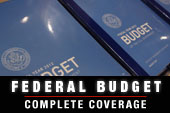With the automatic spending cuts kicking in next week, it’s tough to separate fact from bluster. Both the Obama administration and congressional Republicans chose this week to go with finger-pointing, a subtle acknowledgement that their differences on taxing and spending won’t be bridged by more negotiating.

President Obama and his team warn of government services getting even worse if the $85 billion of across the board cuts in fiscal 2013 are allowed to kick in next Friday—cars stuck idling at under-staffed border posts, furloughed bureaucrats, fewer police and firefighters, thousands of hungry children kicked off government nutrition programs.
Meanwhile, House Speaker John Boehner labors to remind the country that these reductions – or sequestration –were initially a White House-proposed fix in order to raise the debt ceiling back in 2011.
“Right up until the last minute, both the president and the Republicans are going to try to make the most hay out of the issue and make the other guy look bad,” said Steve Ellis, vice president of Taxpayers for Common Sense. “It’s almost like they would rather have the issue than the solution. And I think it’s unfortunate for taxpayers, I think it’s unfortunate for the government, but this is the reality of politics today.”
A few key facts have emerged over the past several days amid the blame game. First, there is a growing consensus that sequestered cuts totaling as much as $1.2 trillion over the next decade won’t lower the national debt. The main drivers of the deficit – Medicare, Medicaid and other entitlement programs—have been exempted from cuts. The second is that while the sequester may use a feckless “meat cleaver” approach to trim spending on defense and many domestic programs it’s not enough to put the whole economy through a meat grinder.
“Is it a calamity? No,” said Douglas Holtz-Eakin, an economist who has advised Republican presidential campaigns and now serves as president of the American Action Forum. “It’s going to look more like the rounding error in GDP. I think there is a lot more noise than light being shed on the sequester.”
Here are the five things you need to know:
No Recession Coming – For all the fear-mongering about hundreds of thousands of furloughs and reduced services, government officials aren’t hyping the possibility of a recession. In a $16.4 trillion economy, the sequester just isn’t big enough.
Macroeconomic Advisers garnered attention this week for predicting that the measure would block the creation of 700,000 jobs by the end of 2014. The sequester lops half a percentage point off from growth, but the Gross Domestic Product would still chug along at a 2 percent pace—not too far off the mark in this tepid recovery. “Not catastrophic,” the firm concluded.
What really matters, economists note, is the issue Obama and Republicans have largely stayed quiet about--$200 billion in tax increases slated for this year as part of the fiscal cliff deal approved on New Year’s Day. Rates ticked up on household incomes above $450,000 and the two-year payroll tax holiday ended, which would likely cause many consumers to open their wallets less often.
Failure to extend the current budget resolution or defaulting on our debt—both possibilities in the months ahead—would be cause for panic.
The Cuts Are Really Less than $85 billion – Politicians keep talking about $85 billion in spending cuts. Technically, you should halve that figure because agencies can draw from stockpiles of unused funds from past years. The sequester applies to how much money is authorized, not how much federal agencies actually spend.
“This excess budget authority rolls over from year to year,” wrote Bank of America economists Ethan Harris and Joshua Dennerlein in a client note. “These programs can use this excess budget authority to count towards their sequester requirements.”
Actual spending cuts would be about $42 billion for the seven months left in this fiscal. Or on an annualized basis, $72 billion for twelve months, according to Bank of America.
Federal Employees Get Screwed – The one warning that echoes across the government is that personnel-heavy agencies can’t use accounting tricks to escape the sequester.
Voters hear about longer security lines at airports, which seems somewhat minor compared to hundreds of thousands of civilian Defense Department employees staring down the possibility of a 20 percent salary decrease. “There is no amount of planning that can avoid these damaging impacts,” Danny Werfel, controller for the Office of Management and Budget, told a Senate panel last week.
G. William Hoagland, a budget expert with the Bipartisan Policy Center, says : “The real hurt will come particularly for those agencies that are personnel-intensive. That would mean the Food and Drug Administration, the FAA and other transportation-oriented infrastructure programs, the FBI and TSA.”
Federal employees get little public sympathy, possibly because unlike the private sector they don’t lose their jobs when they furloughed. They’re often anonymous targets of voter scorn, so it’s logical that politicians would formulate a solution in which they bear the brunt of lower expenditures, rather than the Medicare and Social Security recipients who will fuel deficit-spending in the decades to come.
Congress Could Give Pentagon Some Flexibility – If lawmakers really dread the hollowing out of our armed forces, they could grant the military more leeway in transferring cash among its operations and maintenance accounts, according to a recent analysis by Amy Belaso, a specialist in defense policy and budgets for the Congressional Research Service.
The Pentagon could limit “cuts to readiness-related O&M operating forces to 10 percent to 12 percent, about half the level that the Joint Chiefs of Staff warned would be dangerous in their January letter to Sen. Carl Levin, D-Mich., chairman of the Senate Armed Services Committee.
March 1 Isn’t Set in Stone – The sequester roars in like a lion on March 1, yet it could easily be modified as part of an agreement on funding the government—the continuing resolution expires at the end of next month—or with a deal to raise the debt limit before May 18.
“If this kicks in and remains in force for an appreciable amount of time, I can imagine this discussion getting rolled into the broader discussion of the continuing resolution and the budget for the rest of the year,” said Bill Galston, a senior fellow on government policy at the Brookings Institution. One option on the sequester would be keeping the spending reductions, yet giving agencies more discretion in how to make them.
However, forging any kind of agreement on the budget or the debt ceiling might be tough. Democrats demand that any deal—with an eye toward deficit reduction—include higher tax revenues. House Republicans say the debate has ended on tax increases.
Rep. Tom Cole, R-Okla., recently told The Fiscal Times he anticipates “trench warfare” for the rest of the year on the budget.





